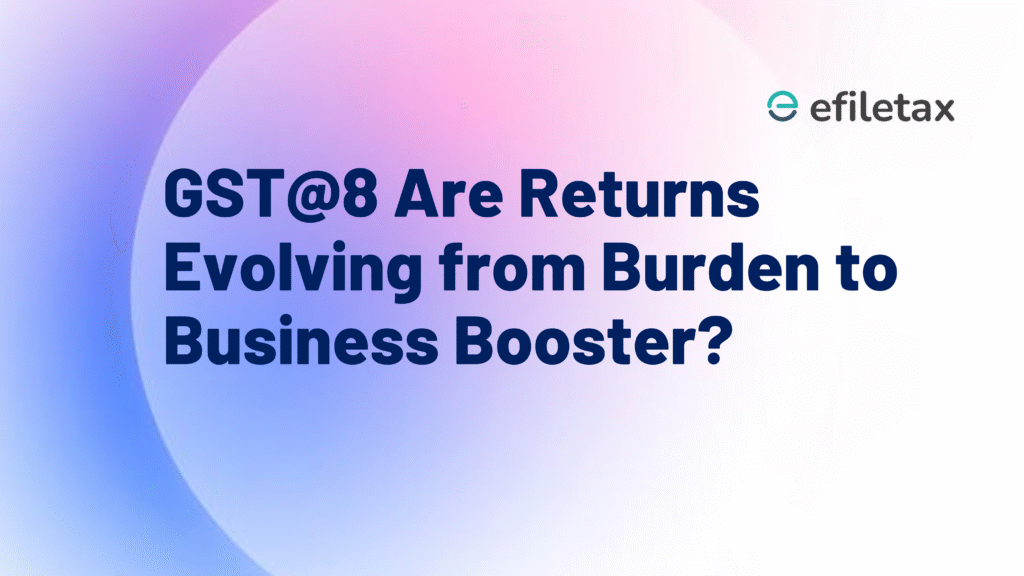
Summary
As GST completes 8 years, India shifts from compliance-heavy GST returns to a trust-based, tech-enabled ecosystem. Here’s how GST@8 is reimagining returns for ease and efficiency.
GST Returns Simplified: GST@8 Pushes for Easy Compliance
India’s Goods and Services Tax (GST) has turned 8. And with it, the GST Council and CBIC are moving towards a bold vision — simplifying GST returns to promote trust, reduce paperwork, and ease compliance for honest taxpayers.
In this blog, we break down how GST@8 is reshaping GST returns using technology, automation, and risk-based governance.
Why Simplifying GST Returns Matters
The GST regime started with high compliance costs —
- Multiple monthly returns
- Complex invoice matching
- Hefty penalties for late filing
- Fear-driven audits
Over time, with input from businesses and professionals, the government realized:
✅ Small businesses need simpler systems
✅ Automation can ease return filing
✅ Trust must replace suspicion in tax governance
Key Highlights of GST@8 Reforms
Here’s how the government is reimagining GST returns:
1. Single Monthly Return System (GSTR-3B)
- GSTR-3B remains the backbone of the return system
- GSTR-1 auto-populates GSTR-3B via invoice matching
- Section 38 changes (w.e.f. 01.10.2022) automate input tax credit (ITC) reporting
✅ Less manual work, more system-driven accuracy
2. Risk-Based Scrutiny & Audit
- Rule 101B & Rule 99 amendments enable selective scrutiny
- AI flags mismatches between GSTR-1 and GSTR-3B
- Honest taxpayers face fewer notices and audits
✅ CBIC’s trust-based approach means less harassment
3. Pre-Filled Returns with Data Analytics
- Data from e-invoicing, GSTR-2B, and EWB auto-pulled
- CBIC is testing pre-filled GSTR-3B for small taxpayers
- Similar to pre-filled ITRs in income tax
✅ Zero-entry filing is now possible for many SMEs
4. Amnesty Schemes for Past Defaults
Under Section 128A of CGST Act (inserted via Finance Act, 2023):
- Amnesty schemes offer relief on past return defaults
- Filing GSTR-9, GSTR-10, and other pending returns allowed with reduced late fees
✅ Fresh start for defaulters willing to comply
5. Unified Compliance Rating System Coming Soon
- As per Section 149 of the CGST Act
- Will rate taxpayers based on timely filing, return accuracy, etc.
- Helps reward compliant taxpayers with faster refunds and fewer audits
Expert Insight:
“The future of GST returns is not about paperwork but platforms. Automation, AI, and real-time data sharing will make return filing as easy as using a banking app.”
— Tax Expert, Efiletax Team
Latest Government Push: GST Appellate Tribunal (GSTAT)
To reduce litigation and streamline appeals:
- GSTAT benches notified across India
- Appeals can now move faster from adjudication to resolution
- Makes return-related disputes easier to contest and resolve
🔗 Read our full blog on GSTAT setup and rules
Practical Tips for Simplifying GST Returns
✅ Use GSTR-2B every month to claim ITC correctly
✅ Avoid mismatch in GSTR-1 and 3B – reconcile before filing
✅ Enable auto-drafting features in your GST software
✅ Opt for e-invoicing (if applicable) to auto-fill data
✅ File returns on time to avoid late fees and ITC blockages
Official References for Trust & Verification
- CBIC GST Portal – Notifications & Circulars
- Section 128A, CGST Act – Amnesty Scheme
- Union Budget 2024 – GST Reforms
- GST Council Press Releases
FAQs
Q1. Will GSTR-3B be scrapped soon?
No. GSTR-3B is being simplified but not scrapped. It may become auto-filled in future.
Q2. What if I made errors in earlier returns?
Use amnesty schemes or file rectifications in annual returns (GSTR-9).
Q3. Can I get notice-free GST compliance?
Yes, if your GSTR-1 and GSTR-3B match and you file on time, audits are rare.
Conclusion: Efiletax Makes GST Filing Easier
At Efiletax, we help thousands of Indian businesses navigate GST returns with ease —
🔹 Pre-filled return support
🔹 Reconciliation reports
🔹 Late filing under amnesty schemes
🔹 Expert tax guidance